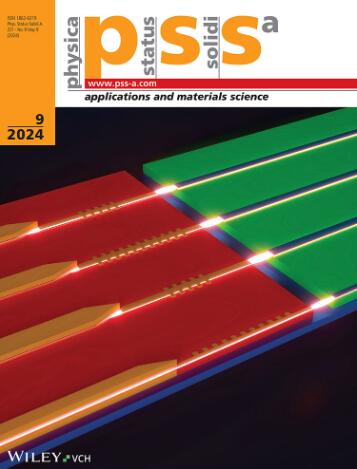纳米晶 Sm4ZrFe33 合金的微结构和磁特性
IF 1.9
4区 材料科学
Q3 MATERIALS SCIENCE, MULTIDISCIPLINARY
Physica Status Solidi A-applications and Materials Science
Pub Date : 2024-08-28
DOI:10.1002/pssa.202400516
引用次数: 0
摘要
这项工作的重点是研究通过高能球磨法制备的 Sm4ZrFe33 纳米晶粉末的微观结构和磁性能。Sm4ZrFe33 复合物采用单斜结构(空间群 Cm)。退火后,这些 Sm4ZrFe33 样品的外磁性能会出现明显变化,这与温度波动密切相关。研究深入探讨了形态、晶粒大小和磁性特征之间的相关性。观察到矫顽力(Hc)、剩磁(Mr)和最大能积((BH)max)明显增强,这主要归因于样品中存在更精细的晶粒结构。特别值得注意的是,在所有退火试样中,在 Ta = 973 K 温度下退火的纳米晶 Sm4ZrFe33 复合物显示出最有前途的磁性能。该试样的矫顽力 Hc 为 18 500 Oe,剩磁(Mr)为 58 emu g-1,最大能积((BH)max)为 5.18 MGOe,居里温度(TC)≈804 K,磁各向异性场(Ha)为 115 980 Oe。这些研究成果为未来利用基于 Sm4ZrFe33 化合物的纳米晶合金在永磁体、自旋电子器件和磁记录领域进行研究和应用铺平了道路。本文章由计算机程序翻译,如有差异,请以英文原文为准。
Microstructural and Magnetic Characteristics of Nanocrystalline Sm4ZrFe33 Alloys
This work focuses on the study of the microstructure and magnetic properties of nanocrystalline powders of Sm4 ZrFe3 3 , prepared by high‐energy ball milling. The Sm4 ZrFe3 3 compound adopts a monoclinic structure (space group Cm). Upon annealing, these Sm4 ZrFe3 3 samples exhibit notable variations in their extrinsic magnetic properties, closely linked to temperature fluctuations. The investigation delves into the correlation between morphology, grain size and magnetic characteristics. A significant enhancement in coercivity (H c ), remanent magnetization (M r ), and maximum energy product ((BH )max ) is observed, primarily attributed to the finer grain structure present in the samples. Particularly noteworthy, among all annealed specimens, the nanocrystalline Sm4 ZrFe3 3 compound annealed at a temperature of T a = 973 K demonstrates the most promising magnetic properties. This specimen exhibits a coercivity H c of 18 500 Oe, remanent magnetization (M r ) of 58 emu g−1 , maximum energy product ((BH )max ) of 5.18 MGOe, Curie temperature (T C ) of ≈804 K, and magnetic anisotropy field (H a ) of 115 980 Oe. These research findings pave the way for future investigations and applications in the realm of permanent magnets, spintronic devices, and magnetic recording, utilizing nanocrystalline alloys based on the Sm4 ZrFe3 3 compound.
求助全文
通过发布文献求助,成功后即可免费获取论文全文。
去求助
来源期刊
CiteScore
3.70
自引率
5.00%
发文量
393
审稿时长
2 months
期刊介绍:
The physica status solidi (pss) journal group is devoted to the thorough peer review and the rapid publication of new and important results in all fields of solid state and materials physics, from basic science to applications and devices. Among the largest and most established international publications, the pss journals publish reviews, letters and original articles, as regular content as well as in special issues and topical sections.

 求助内容:
求助内容: 应助结果提醒方式:
应助结果提醒方式:


